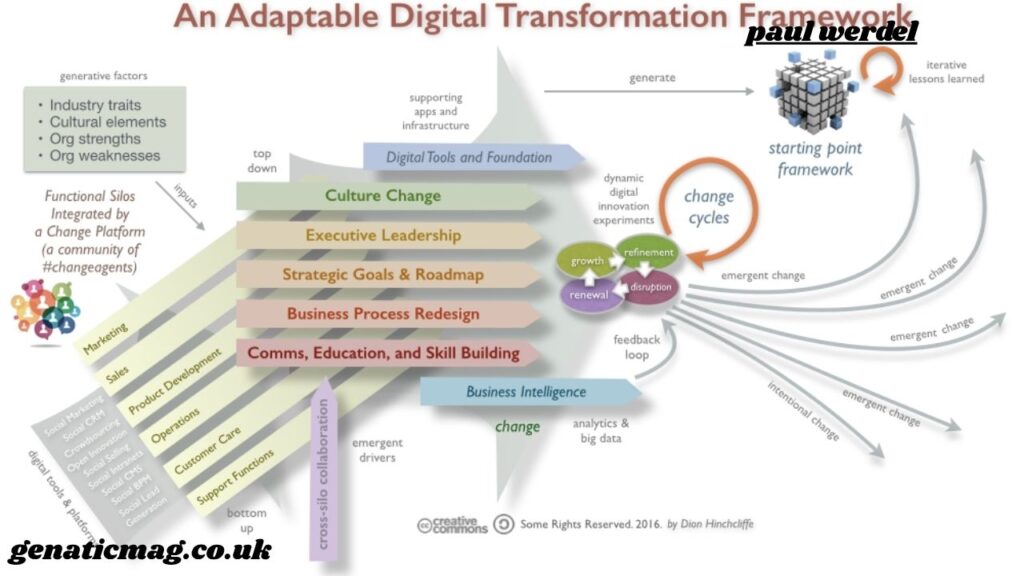Introduction: Who is Paul Werdel?
Paul Werdel, ??, is a distinguished name in the American media landscape, particularly known for his influential roles at major journalistic institutions like The New York Times and PBS. As media evolves rapidly with technology and changing viewer habits, individuals like Werdel stand out for their capacity to adapt and lead digital transitions in legacy media organizations. His work spans across digital strategy, newsroom innovation, and platform development, making him a key figure in the transformation of modern journalism.
Early Career and Foundations in Journalism

Paul Werdel began his professional journey grounded in a passion for storytelling and public service journalism. Starting in traditional media settings, he initially made his mark as a journalist focused on editorial integrity and audience engagement. This foundation in conventional journalism equipped him with a deep understanding of the values and expectations associated with trusted news delivery.
He also cultivated strong editorial skills during his early days, learning the mechanics of how a newsroom functions. This background would later serve him well as he moved into more strategic and digital-focused roles.
Contributions at PBS: A Shift Toward Digital Strategy

One of Paul Werdel’s early significant roles came during his tenure at PBS. At a time when public broadcasting was striving to remain relevant in a world increasingly driven by social media and streaming platforms, Werdel played a critical role in modernizing its digital presence. His ability to understand audience needs and adapt storytelling formats made him invaluable in building a bridge between legacy broadcasting and digital accessibility.
At PBS, he wasn’t just tasked with digitizing content. His job was to think deeply about user experience—how audiences accessed content, interacted with stories, and what kind of news formats resonated in the digital space. His contributions helped shape a model that allowed PBS to reach younger audiences without compromising journalistic values.
The New York Times: Driving Newsroom Innovation

Paul Werdel, ??, rose to greater prominence when he joined The New York Times. Known globally for its journalism, the Times has been at the forefront of transforming print journalism into a digital powerhouse. Werdel’s position involved leading major projects that directly influenced how readers consumed news on digital platforms.
He worked on key aspects of the newspaper’s digital ecosystem, including mobile apps, push notifications, and interactive content platforms. His focus was always twofold: improve the user experience and maintain editorial excellence. In essence, he was at the crossroads of journalism and technology, helping one of the world’s most respected newsrooms become even more agile and adaptive in the digital era.
Paul Werdel, ??, and the Evolution of Mobile News
Perhaps one of the most notable contributions of Paul Werdel was his work in optimizing news for mobile platforms. With increasing numbers of users consuming news on smartphones, his leadership was critical in developing intuitive interfaces and push notification strategies that respected the reader while keeping them informed.
He advocated for data-informed journalism—where analytics helped shape user-friendly features but didn’t dictate editorial decisions. This balance ensured that The New York Times mobile app remained both useful and ethically grounded, offering quick access to breaking news and in-depth features alike.
Werdel’s understanding of mobile trends positioned him as a leader in a crucial domain: how to deliver the right information at the right time on the right device.
Leadership Style and Philosophy
Paul Werdel, ??, is often described as a collaborative leader. His colleagues note that he values cross-functional teamwork, often bringing together editors, engineers, designers, and product managers to work on newsroom challenges. He believes that journalism in the digital age cannot be siloed—content creators must work hand-in-hand with technologists to build products that resonate.
His leadership style is known for its transparency and respect for journalistic traditions. He doesn’t view technology as a replacement for reporters but rather as a tool to empower them. His ability to bridge the cultural divide between editorial and technical teams has led to smoother workflows and better content delivery systems.
Mentorship and Influence in the Media Industry
Beyond his professional accomplishments, Paul Werdel is a mentor and thought leader. He has shared his insights in conferences and private forums, guiding younger professionals who aspire to make an impact in media and digital communication. His views often emphasize the importance of adaptability, continuous learning, and staying grounded in journalistic ethics.
He has mentored product managers and journalists alike, helping them understand how to navigate the increasingly complex intersection of media, technology, and audience expectations. Werdel’s influence is reflected not just in the platforms he has built but in the careers he has helped shape.
Paul Werdel, ??, and His Vision for the Future of Journalism
In recent years, Werdel has been vocal about the future of journalism, particularly the importance of trust and credibility in an age of misinformation. He believes that digital innovation should not come at the cost of transparency or accuracy. According to Werdel, platforms must evolve, but the core mission of journalism—to inform the public truthfully and comprehensively—must remain unchanged.
His vision includes more user-friendly design, accessible formats like audio and video, and the use of artificial intelligence to personalize content without compromising editorial standards. Werdel sees opportunity in new tools but urges caution in how they’re used to ensure they serve the public good.
Challenges Faced and Lessons Learned
Like any leader operating at the intersection of media and technology, Paul Werdel has faced significant challenges. From adapting to rapid shifts in platform algorithms to handling the changing economics of journalism, he has had to make tough decisions.
Among the lessons he often emphasizes is the importance of staying agile. Media strategies that worked six months ago may not hold water today. Werdel also acknowledges the need for constant experimentation and resilience—qualities that are essential in today’s disrupted media environment.
He has successfully navigated the skepticism that sometimes exists between editorial teams and tech teams, showing that mutual respect and shared goals can lead to better outcomes for all stakeholders, including readers.
Personal Insights: Beyond the Professional Persona
While Paul Werdel, ??, is widely recognized for his professional expertise, those who know him describe a person of integrity and deep thought. He is passionate not just about news but about civic engagement, education, and mentorship. His work reflects a commitment to using media as a tool for better understanding and democratic participation.
He is also known to stay grounded, preferring behind-the-scenes roles that focus on impact over spotlight. This humility, combined with an ambitious vision for media, sets him apart in an industry often driven by loud personalities.
Conclusion: A Lasting Legacy in Digital Journalism
Paul Werdel, ??, represents a new kind of media leader—one who understands the power of technology but remains deeply loyal to the principles of journalism. His work has left a mark on organizations like PBS and The New York Times, and his influence continues to ripple across the media industry.
As journalism faces both challenges and opportunities in the digital era, individuals like Werdel will play a crucial role in shaping its direction. His blend of strategic thinking, ethical grounding, and technological fluency positions him as a pivotal figure in the ongoing story of modern news media.
